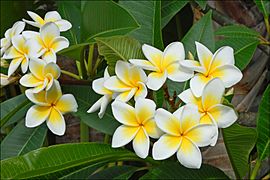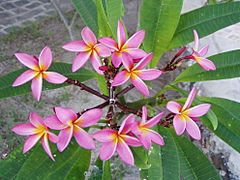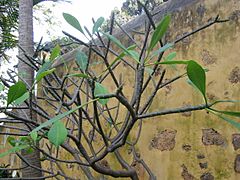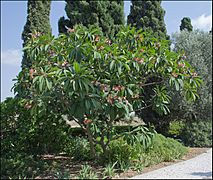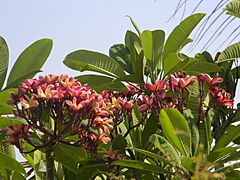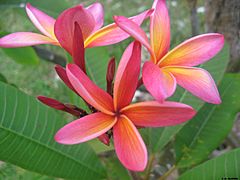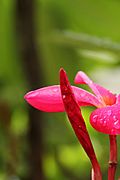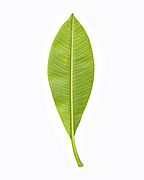Plumeria rubra facts for kids
Quick facts for kids Plumeria rubra |
|
|---|---|
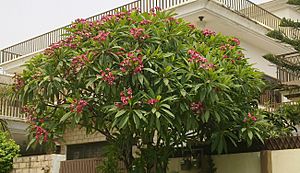 |
|
| Tree with pink flowers in Pakistan | |
| Scientific classification | |
| Genus: |
Plumeria
|
| Species: |
rubra
|
| Synonyms | |
|
List
|
|
The Frangipani (scientific name: Plumeria rubra) is a beautiful plant known for its amazing flowers. It's a deciduous plant, which means it loses its leaves every year, usually in cooler months. This plant is part of the Plumeria family.
Frangipani trees originally came from places like Mexico, Central America, Colombia, and Venezuela. Today, you can find them growing all over the world in warm, sunny places. They are very popular in gardens and parks. People also plant them near temples and in cemeteries. These trees can grow to be about 7 to 8 meters (23 to 26 feet) tall and just as wide. In summer and autumn, they are covered with sweet-smelling flowers. These flowers come in lovely shades of pink, white, and yellow.
The famous scientist Carl Linnaeus first described Plumeria rubra in 1753. Its scientific name, rubra, comes from the Latin word for "red." You might hear it called by many common names, like frangipani, red paucipan, red-jasmine, temple tree, or simply plumeria.
Contents
What's in a Name?
The common name "frangipani" has an interesting story. It comes from an Italian noble family called Frangipani. A member of this family in the 1500s created a perfume that smelled like the plumeria flower.
The name of the plant genus, Plumeria, honors Charles Plumier. He was a French monk and a botanist, someone who studies plants.
In Mexico, people call this flower cacaloxóchitl. This name comes from an ancient language called Nahuatl. It means "crow's flower." In 1971, Plumeria rubra became the national flower of Nicaragua. There, it is known as sacuanjoche.
Frangipanis have many other names around the world. In Spanish, they are called alhelí or suche. In Hawaii, the name is melia. People in the Cook Islands call it tipani. In India and Pakistan, it's often known as champa. In Cambodia, it's châmpéi krahâ:m, meaning 'red flower'. In Sri Lanka, it's araliya. In Brazil, it has names like jasmim-manga. In China, it's ji dan hua.
Plant Features
The Frangipani belongs to the dogbane family. It grows as a large bush or a small tree. It can reach a height of 2 to 8 meters (6.5 to 26 feet) and be just as wide. The tree has a thick, juicy trunk and blunt, sausage-shaped branches. These branches are covered with thin, gray bark.
The branches are a bit fragile. If you break one, a white, milky sap will ooze out. This sap can irritate your skin or mouth, so it's best not to touch it. The sap is considered toxic, but it's not deadly unless someone consumes a very large amount.
The leaves are large and green, growing up to 30 to 50 centimeters (12 to 20 inches) long. They grow in groups at the ends of the branches. The main trunk of the plant can be up to 25 cm (10 inches) thick in the wild. When grown in gardens, it usually stays smaller.
Frangipani trees lose their leaves during the cooler months. The flowers grow at the ends of the branches during the summer. They are often very plentiful and easy to see. These flowers have a strong, pleasant smell, especially in the morning and evening. Their scent is like a mix of rose, citrus, and cinnamon.
Each flower has five petals. They start as a tube shape and then open up. The flowers are about 5 to 7.5 centimeters (2 to 3 inches) wide. They come in colors from pink to white, often with yellow in the center. The flowers rarely produce seeds. When they do, a pod about 17.5 centimeters (7 inches) long forms. This pod holds 20 to 60 winged seeds.
Where Frangipanis Grow
The Frangipani tree is originally from central Mexico. Its natural home stretches south through Central America to Colombia and Venezuela in South America.
Today, people grow Frangipanis all over the world in tropical areas. It has even started growing wild in some parts of India. You can find P. rubra in many countries, including South Africa, Yemen, China, and Pakistan. It grows almost everywhere in Myanmar, except in very cold mountain areas.
Frangipanis usually grow in hot, rocky places. They prefer areas with dry to moderate rainfall. They can survive in places with long dry seasons. In these conditions, they might flower on bare branches. In more humid places, their leaves can stay green all year. You can find them in rocky forests, on mountain slopes, and sometimes even on plains. They usually grow at elevations of 500 to 1000 meters (1,640 to 3,280 feet), but can be found up to 1500 meters (4,920 feet) high.
Growing Frangipanis
People grow Frangipanis in gardens and parks all over the world. In places like Sydney and Perth, Australia, and in warm parts of the United States, they are very common. They also grow well in Hawaii, even at high altitudes.
These plants can grow in many different types of soil. They like soil that drains well and gets lots of sun. In tropical areas, they can bloom for most of the year. However, they don't like wet soil. If temperatures drop below 10 degrees Celsius (50 degrees Fahrenheit) in winter, the plants will stop blooming and lose their leaves.
Once established, Frangipanis can handle salty conditions and even salty winds. It's easy to grow new Frangipani plants from cuttings. You can take a branch cutting in cooler months and let it dry for a week or more before planting. Besides gardens, Frangipanis are often planted near temples and in cemeteries.
In Hawaii, Plumeria rubra is a very important plant. In 2005, over 14 million Frangipani flowers were sold there to make leis, which are flower necklaces.
In cooler areas, like parts of the United Kingdom, P. rubra needs to be grown indoors in a large greenhouse. This is because it cannot handle temperatures below 10 degrees Celsius (50 degrees Fahrenheit). But you can move it outside to a sunny, sheltered spot during the summer. The Royal Horticultural Society in the UK has given it an award for being a great garden plant.
Some Frangipani plants you see are mixes of P. rubra and another species called Plumeria obtusa. These mixed plants often have rounder leaves and are less likely to lose their leaves in winter. A white and yellow type called "Singapore" flowers all year round in Hawaii.
Sometimes, a fungus called Coleosporium plumeriae attacks young Frangipani leaves. This fungus is also known as plumeria rust. It causes a brownish or orange powdery coating or blisters on the leaves. It has been seen in Hawaii and on the east coast of Australia.
Uses of Frangipani
The USDA Forestry Service says that Plumeria rubra is a poisonous plant. They warn against touching or eating any part of it.
In Cambodia, people use P. rubra flowers to make necklaces. They also offer them to gods or use them to decorate coffins. The leaves of this plant are used to help with sores and can be made into soothing liquids.
The flowers and bark are used in traditional Chinese medicine. They are used to help treat things like fever and coughs.
P. rubra contains a substance called fulvoplumierin. This substance can act as an antibiotic. The plant has also been shown to have properties that fight fungi and viruses. It can also help with pain, muscle spasms, and blood sugar levels.
The sap from the plant is sometimes used as a laxative. It can also be a remedy for bloating and stomachaches. The bark is said to help with digestion. The flowers can be boiled in water or juice and made into a salad. This is believed to help with bowel movements, urine flow, and to control gas. The flowers are also used to help with asthma.
On the island of Molokai in Hawaii, P. rubra is grown to make flower necklaces called leis. The flowers are also used to make scented oil in many Pacific islands, including Hawaii. They are used to add scent to coconut oil. The wood of the Frangipani tree is hard and has a fine texture. It can be polished to a high shine.
Gallery
Images for kids
-
Flower of Plumeria rubra in West Bengal, India.
-
Closeup of Plumeria rubra or red frangipani in Jamshedpur
See also
 In Spanish: Frangipani para niños
In Spanish: Frangipani para niños


